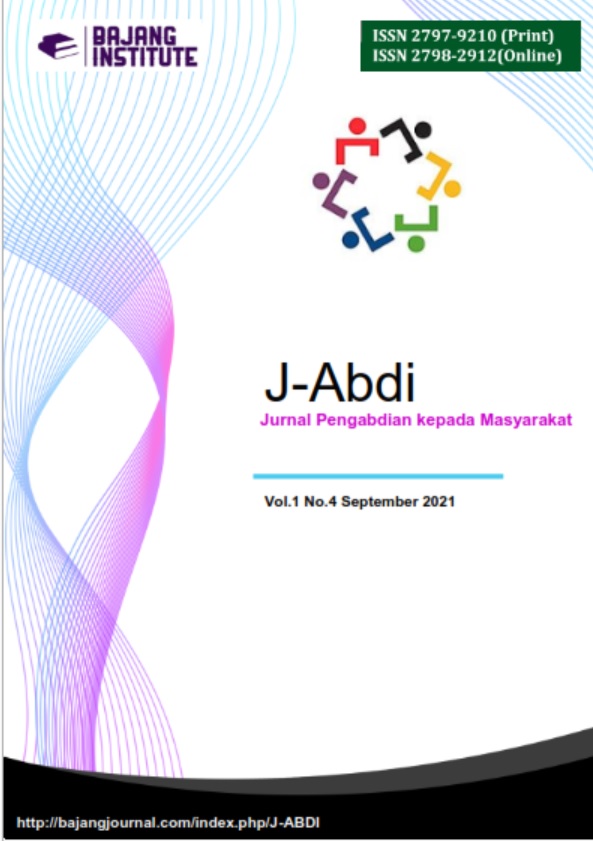BUDAYA LOKAL BERAWAL DARI RUMAH SEBAGAI INSTRUMEN PENINGKATAN KUALITAS KEDISIPLINAN PELAJAR
DOI:
https://doi.org/10.53625/jabdi.v1i4.160Keywords:
local culture, Sasak, student, teenager, disciplineAbstract
Local culture control individual behavior in entire life. Symbols, meanings, and values of local culture has been shifted. Local culture is even almost extinct so it needs to be preserved by the teenager especially students as a group of cultural heirs, such as students at MTs and MA Al-Jamil, Batukliang Utara, Lombok Tengah. Efforts to preserve local culture are carried out by giving knowledge about Sasak culture. The method of this assistance has four stages what is preparation, initial observation, implementation, and evaluation. The result of this assistance is knowledge and understanding enhancement about the symbols, meanings, and values of Sasak culture. This is initial stage to internalizing the values contained in local culture such as discipline in daily life.
References
Alam, and Bachtiar. “Globalisasi Dan Perubahan Budaya: Perspektif Teori Kebudayaan.” Antropologi Indonesia 0, no. 54 (July 16, 2014). Accessed August 5, 2021. http://www.ijil.ui.ac.id/index.php/jai/article/view/3325.
Brown, H. Brown, H.D. (2006). Principles of Language Learning and Teaching. 5th Ed. Prentice-Hall Regents. 5th ed. White Plains NY: Pearson Longman, 2007.
Budiarto, Gema. “Dampak Cultural Invasion Terhadap Kebudayaan Lokal: Studi Kasus Terhadap Bahasa Daerah.” Pamator Journal 13, no. 2 (October 29, 2020): 183–193. Accessed August 12, 2021. https://journal.trunojoyo.ac.id/pamator/article/view/8259.
Hilmi, Muhammad Zoher. “NILAI-NILAI KEARIFAN LOKAL DALAM PERILAKU SOSIAL ANAK-ANAK REMAJA DI DESA SEPIT KECAMATAN KERUAK KABUPATEN LOMBOK TIMUR.” Journal of Educational Social Studies 4, no. 1 (2015): 1–7. Accessed August 5, 2021. https://journal.unnes.ac.id/sju/index.php/jess/article/view/6867.
Johannes, Nathalia Yohanna, Samuel Patra Ritiauw, Elsinora Mahananingtyas, and Nurhayati Nurhayati. “IMPLEMENTASI PEMBELAJARAN BERBASIS BUDAYA LOKAL DALAM MENINGKATKAN SIKAP POSITIF DISIPLIN SISWA SEKOLAH DASAR.” Jurnal Bimbingan dan Konseling Terapan 3, no. 2 (July 1, 2019): 84–94. Accessed August 5, 2021. https://ojs.unpatti.ac.id/index.php/bkt/article/view/1110.
Kadarisman, A. Effendi. Mengurai Bahasa, Menyibak Budaya : Bunga Rampai Linguistik, Puitika, Dan Pengajaran Bahasa. Malang: UIN-Maliki Press, 2010. Accessed August 5, 2021. http://repository.uin-malang.ac.id/1266/.
Larasati, Dinda. “Globalization on Culture and Identity: Pengaruh Dan Eksistensi Hallyu (Korean-Wave) Versus Westernisasi Di Indonesia.” Jurnal Hubungan Internasional 11, no. 1 (November 1, 2018): 109–120. Accessed August 5, 2021. https://www.e-journal.unair.ac.id/JHI/article/view/8749.
Mujib, Ahmad. “HUBUNGAN BAHASA DAN KEBUDAYAAN (Perspektif Sosiolinguistik) HUBUNGAN BAHASA DAN KEBUDAYAAN (Perspektif Sosiolinguistik).” Adabiyyāt: Jurnal Bahasa dan Sastra 8, no. 1 (June 19, 2009): 141–154. Accessed August 12, 2021. http://ejournal.uin-suka.ac.id/adab/Adabiyyat/article/view/654.
Nahak, Hildgardis M.I. “UPAYA MELESTARIKAN BUDAYA INDONESIA DI ERA GLOBALISASI.” Jurnal Sosiologi Nusantara 5, no. 1 (June 25, 2019): 65–76. Accessed August 5, 2021. https://ejournal.unib.ac.id/index.php/jsn/article/view/7669.
Rohman, Abdul. “PEMBIASAAN SEBAGAI BASIS PENANAMAN NILAI-NILAI AKHLAK REMAJA.” Nadwa: Jurnal Pendidikan Islam 6, no. 1 (June 21, 2016): 155–178. Accessed August 10, 2021. https://www.journal.walisongo.ac.id/index.php/Nadwa/article/view/462.
Sam’un, Ahmad. “SIMBOL DAN MAKNA BUDAYA NYAWE? DAN BERAS PATI: UPAYA PEMERTAHANAN BAHASA MASYARAKAT SASAK.” LINGUA : Jurnal Bahasa, Sastra, dan Pengajarannya 14, no. 1 (January 14, 2017): 79–88. Accessed August 5, 2021. https://lingua.soloclcs.org/index.php/lingua/article/view/242.
———. “WARIGE AS A SYMBOL CONTAINING CRUCIAL MEANING IN SASAK COMMUNITY’S CULTURE AND ITS RELATION TO LANGUAGE MAINTAINABILITY.” In International Seminar Bali Hinduism, Tradition and Interreligious Studies, 355–362. Denpasar-Bali: Hindu University of Indonesia, 2018.














